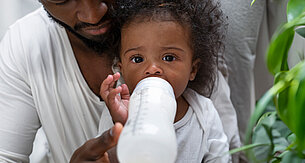What's in breastmilk?

Breastmilk is a miracle of nature - it contains everything your baby needs for healthy growth and development. At HiPP, we have been researching the composition of breastmilk and its many components for over 50 years. We use this research, along with the work of many other experts and scientists from all around the world, to better understand what makes breastmilk so unique, and we use this information to help improve our milk formulas for babies when you choose not to breastfeed your baby.
Nutritionally complete
The composition of breastmilk varies from mother to mother, throughout the breastfeeding period, throughout a feed, throughout the day, and from day to day. But you can be certain your breastmilk contains all the nutrients your baby needs for the first few months of life, including protein, energy, fatty acids, vitamins, minerals and trace elements, in the perfect quantities. To make sure your milk is nutritious and plentiful, it is important to eat a healthy, balanced diet while breastfeeding and drink plenty of water.
Fats and Omega 3 & 6 LCPs
Fat is the most highly variable component of breastmilk. The fat content of breastmilk varies between mothers (22.3–61.6 g/L) and within and between breastfeeds1. Maternal diet also influences the fatty acid profile of breastmilk, especially the long chain polyunsaturated fatty acids (called LCPs) which are unsaturated fats that play many useful roles in the body2. Two of the most significant LCPs are the Omega 3 LCP (known as DHA), and the Omega 6 LCP (known as AA). AA and DHA are important components of the brain and the retina (inside the eye); this makes them especially important for your baby's rapidly-growing brain and developing vision3.
Other important natural substances
Breastmilk also contains lots of other important substances that contribute to your baby’s healthy development, including:
- Human milk oligosaccharides (HMOs) - These are indigestible complex sugar molecules which support your baby’s immune system and strengthen their defenses. This in turn will help promote healthy and comfortable digestion. Breastmilk contains lots of different types of these oligosaccharides, which also help soften the stools of breastfed babies4.
- Human milk microbiota – a wide range of different types of microorganisms are present in breastmilk; some are common to the breastmilk of all mothers, but others will differ depending on your nutrition and own immunity, environmental and lifestyle factors. These microorganisms will be passed onto your baby and help to shape their own unique intestinal microbiota, which helps protect them against infections2.
- Antibodies (immunoglobulins) and anti-infective agents which help build your baby’s defenses.
- Lactoferrin: a protein that helps babies absorb nutrients such as iron and has strong anti-bacterial properties
- Numerous growth factors that have wide-ranging effects on the gut, blood, nervous system, and on hormones which regulate metabolism and body composition.
And there are many other ingredients that have not yet been fully identified or explored!
Together, the nutrients and the numerous other biological components of breastmilk ensure optimal digestion, nutrient absorption, metabolism, development and protection against infections, making it the best food for your baby.





